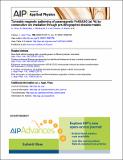Por favor, use este identificador para citar o enlazar a este item:
http://hdl.handle.net/10261/44626COMPARTIR / EXPORTAR:
 SHARE SHARE
 CORE
BASE CORE
BASE
|
|
| Visualizar otros formatos: MARC | Dublin Core | RDF | ORE | MODS | METS | DIDL | DATACITE | |

| Título: | Tuneable magnetic patterning of paramagnetic Fe60Al40 (at. %) by consecutive ion irradiation through pre-lithographed shadow masks |
Autor: | Varea, Aïda; Menéndez, Enric CSIC ORCID; Montserrat Martí, Josep CSIC ORCID ; Lora-Tamayo D’Ocón, Emilio; Nogués, Josep CSIC ORCID; Sort, Jordi CSIC ORCID | Fecha de publicación: | 2011 | Editor: | American Institute of Physics | Citación: | Journal of Applied Physics 109(9): 093918 (2011) | Resumen: | Arrays of ferromagnetic circular dots (with diameters ranging from 225 to 420 nm) have been prepared at the surface of atomically ordered paramagnetic Fe60Al40 (at. %) sheets by means of ion irradiation through prelithographed poly(methyl methacrylate) (PMMA) masks. The cumulative effects of consecutive ion irradiation (using Ar+ ions at 1.2 × 1014 ions/cm2 with 10, 13, 16, 19 and 22 keV incident energies) on the properties of the patterned dots have been investigated. A progressive increase in the overall magneto-optical Kerr signal is observed for increasingly larger irradiation energies, an effect which is ascribed to accumulation of atomic disorder. Conversely, the coercivity, HC, shows a maximum after irradiating at 16–19 keV and it decreases for larger irradiation energies. Such a decrease in HC is ascribed to the formation of vortex states during magnetization reversal, in agreement with results obtained from micromagnetic simulations. At the same time, the PMMA layer, with an initial thickness of 90 nm, becomes progressively thinned during the successive irradiation processes. After irradiation at 22 keV, the remaining PMMA layer is too thin to stop the incoming ions and, consequently, ferromagnetism starts to be generated underneath the nominally masked areas. These experimental results are in agreement with calculations using the Monte-Carlo simulation Stopping Range of Ions in Matter software, which show that for exceedingly thin PMMA layers Ar+ ions can reach the Fe60Al40 layer despite the presence of the mask. | Descripción: | 8 páginas, 8 figuras.-- et al. | Versión del editor: | http://dx.doi.org/10.1063/1.3590158 | URI: | http://hdl.handle.net/10261/44626 | DOI: | 10.1063/1.3590158 | ISSN: | 0021-8979 | E-ISSN: | 1089-7550 |
| Aparece en las colecciones: | (CIN2) Artículos (IMB-CNM) Artículos |
Ficheros en este ítem:
| Fichero | Descripción | Tamaño | Formato | |
|---|---|---|---|---|
| Tuneable magnetic patterning.pdf | 3,16 MB | Adobe PDF |  Visualizar/Abrir |
CORE Recommender
SCOPUSTM
Citations
10
checked on 16-abr-2024
WEB OF SCIENCETM
Citations
9
checked on 27-feb-2024
Page view(s)
325
checked on 17-abr-2024
Download(s)
250
checked on 17-abr-2024
Google ScholarTM
Check
Altmetric
Altmetric
NOTA: Los ítems de Digital.CSIC están protegidos por copyright, con todos los derechos reservados, a menos que se indique lo contrario.
